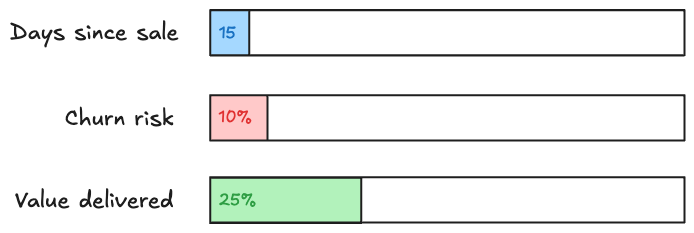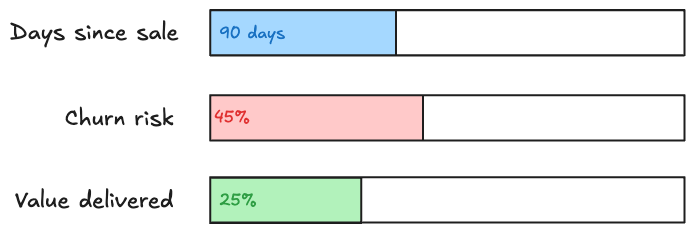#1 Cause of Churn? Slow Time-to-Value.
 Jai Thirani5 min read
Jai Thirani5 min readThere is always a small percentage of churn that is out of your hands (company shuts down, team gets fired, etc.) but most customers churn because they don’t see value fast enough. You would think that most of this churn risk is introduced across the customer journey. However, even on day 0, when you have just signed a customer, there is a non-zero churn risk by default. Why? Because, at this point, they have high expectations of value and zero realized value. This delta represents initial churn risk that you’re already in a fight against.

Is your onboarding process a potential churn risk?
The steps to get customers to value vary greatly for each product. If your product is like Calendly or ChatGPT, where customers see value in the first few minutes, this post isn’t for you. We’re focusing solely on softwares that take between 1 week to 1 year to go live. Softwares like ERPs, HR & payroll systems, supply chain systems, etc. where there are often setups, data migrations, custom integrations, trainings, etc.
In such cases, there is a minimum sequence of tasks that need to be completed before your customer can start to see value. This is where churn has its roots.
Time is your enemy
If you’re in this category of products, time is your enemy. If you make no progress in getting the customer closer to value and let’s say 30 days pass by, the churn risk has only gone up. If your sales process creates expectations of specific implementation times, falling behind on them especially introduces churn risk.

It is important to realize that at some point in time, it will be too late to reverse this churn risk no matter what you do and at renewal your customer will churn.

Clearly, you need to provide value to the customer.
How to define “value”?
For most products, value isn’t derived all at once. There are different value checkpoints. Let’s take Slack as an example. Slack helps customers streamline and centralize communication leading to improved productivity and faster decision-making. In getting to this expected value, there are several checkpoints -
- A user is able to have a conversation with another member on their team
- Multiple users are able to collaborate in a channel
- Other tools can be spoken to directly via Slack Apps.
Like Slack, every product has a different set of value checkpoints. They could sequential or they could be completed in any order. Either way, they need to be clearly defined. Without knowing what your value checkpoints are, you will never be able to measure whether customers are seeing value.
Time-to-value (TTV)
Simply getting customers to value is not enough though. The amount of time you take to get customers there is what is critical. If customers don’t see value early into the purchase, they are at the risk of reverting to their old ways, exploring competitors or just going silent.
Time-to-value (TTV) is a measurement of the time it takes from the point of sale to get to value. It can further be broken down into time-to-first-value, time-to-second-value… and so on for each of your value checkpoints.
TTV is extremely powerful because it gives you a leading indicator of churn. For example, if your time-to-first-value (TTFV) is 15 days, your churn risk might come down from the initial 20% to 10%.

However if your TTFV is 90 days, the churn risk could have actually gone up to 45% even though you’ve made the same amount of progress.

TTV gives you a KPI to track in operationalizing your onboarding process. At the same time, it enables your customer success team to understand what part of their book of business is at inherent risk to begin with and needs more focus.
Hows does slow TTV manifest itself?
TTV is clearly an important metric. But why isn’t it looked at when a customer is about to churn? The reason is no customer churns saying “We’re going to use your competitor instead because we didn’t see value early enough”. Based on an extensive churn analysis of our customer base, we see that they usually list other reasons such as “the integration never went live” or “budgets are tight” or “our team isn’t using the tool”.
Diving deeper into these cases, it is obvious that these are just proxies for slow time-to-value. An integration not going live prevents your customer from hitting one of their value checkpoints. Your customer isn’t able to justify the budget for your tool because they never saw value early enough into the contract to have a return on their investment. Your customer’s team isn’t using your tool because they didn’t reach see personal value that enabled them to build a habit.
When a customer is about to churn, you should of course focus on saving them with everything you can possibly do. But ever so often, that is where the effort stops. Teams ignore the real issue that most likely made the customer a churn risk in the first place - slow time-to-value.
How to solve this?
If you reverse engineer why customers are having slow time-to-value, it is largely because they were poorly onboarded. They weren’t taken through the critical sequence of tasks during implementation within the required timeline. Either the customer dropped off and wasn’t held accountable or your internal team let them slip through the cracks.
In order to turn this around and create a high quality and repeatable onboarding process, you need the right workflow. Internal teams and customers need shared visibility into what needs to be done, who needs to do it, how it needs to be done and by when. You need analytics that can surface onboardings that are going off track so you have a leading indicator of churn. You need automations that create customer accountability and escalations that keep internal teams in check. You need to introduce an incentive program (implemention fee or discount for early onboarding) for customers so that they are more engaged. You need to centralize communication, resource sharing, training… and more.
Why we started Sero
Creating an exceptional onboarding experience isn’t easy but it is a science. We started Sero to convert this science into a reality. Our all-in-one tool helps you increase team bandwidth, create a phenomenal customer onboarding experience and most importantly, accelerate time-to-value. We are the #1 platform to interact and create accountability with customers. Our purpose built features such as external facing views and AI drafted emails just scratch the surface.
If you’re looking to set up your customers for long term success, it starts with the foundation of world class onboardings!
If you’re looking to set up your customers for long term success, it starts with the foundation of world class onboardings!
Book a demo to see how Sero can help you accelerate time-to-value.